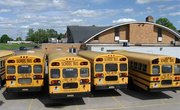Suburban or urban? That is the question. Parents may spend hours trying to get their child enrolled in a suburban school, but is it the best education for their child? There are some advantages to attending a school nestled in the outlying areas of a sprawling city. If you are considering moving a child from an inner-city school to a renowned suburban school, there are a few factors to consider.
Characteristics of a Suburban School
Suburban schools often reflect the affluence of the surrounding neighborhoods. More affluent families tend to have more time to be involved in the school and to be home with children before and after school. This can lead to a more cohesive home life and a subsequent higher performance level from children who attend a suburban school.
A suburban school is usually defined by:
- A location in the outer edges of a metropolitan city
- A large middle-class and white majority of students
- Families who have immigrated from the urban areas of the city
- Classrooms that are better furnished with the latest technology and newest equipment
History of Suburban Schools
Suburban schools popped up in the last half century or so out of a need to educate the children of families who moved away from overpopulated inner cities. The open spaces and fresh air of the sprawling suburbs were attractive to middle-class families who were cloistered in cramped apartments on narrow streets in overcrowded cities.
Characteristics of Urban Schools
Children in an urban school tend to receive lower grade averages due to the teacher’s time constraints and the lack of ability to be involved in one-on-one instruction as well as the lack of an out-of-school support system. Urban schools often post jobs that require a social science degree. Social and behavioral science degree careers can get a head start through working with students in urban and suburban schools.
Characteristics of urban schools tend to lean toward independent students and teachers. Educators strive to pinpoint students who can thrive beyond the classroom. Urban schools tend to have students who are less likely to come from a stable family home due to financial and environmental stresses.
Students in urban schools are more likely to switch schools due to changes in a parent’s job or the need to find more affordable housing. This can lead to a loss of time spent in the classroom or time dedicated to homework and studying.
Advantages of a Suburban School
Suburban schools tend to have less crime due to the parental involvement and abundance of technological, athletic and other after-school programs. Teachers tend to have more support and funding from the families of the school’s students. This creates a significant increase in the potential for children to learn.
Students who have the support of parents, extended family, friends and the community tend to thrive over students who attend school and events without any personal backing.
Disadvantages of a Suburban School
A suburban school can be tied up in scoring levels in order to keep any funding or community ratings in place. Students can get lost within the need for a suburban school to maintain a good standing on many different levels and for a variety of funders.
While parents at suburban schools have an opportunity to be more involved, that doesn’t always raise the level of education for all of the students. In order to maintain a good standing, high-achieving students can get mired in average studies, while lesser-achieving students can be pushed along to keep up scoring.
Related Articles
References
Writer Bio
Kimberley McGee is an award-winning journalist with 20+ years of experience writing about education, jobs, business trends and more for The New York Times, Las Vegas Review-Journal, Today’s Parent and other publications. She graduated with a B.A. in Journalism from UNLV. Her full bio and clips can be seen at www.vegaswriter.com.











